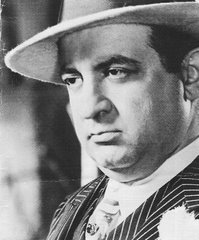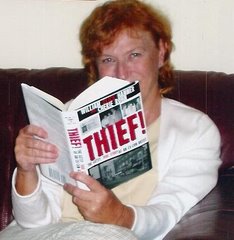
Ike Atkinson Interview
I’d seen the movie “American Gangster” starring Denzel Washington as Frank Lucas. I’d also heard that much of the movie’s contents had been distorted or even made up, a common Hollywood practice to “beef up” a story. I wondered what’s the truth behind the two controversial figures, Frank Lucas and another drug smuggler, Ike Atkinson also depicted in the movie? So when fellow crime writer Ron Chepesiuk invited me to interview Ike Atkinson, the subject of his new book Sergeant Smack, I leapt at the chance.
In Sergeant SMACK: The Legendary Lives and Times of Ike Atkinson, Kingpin, and his Band of Brothers author Ron Chepesiuk describes his main character:
“Leslie 'Ike' Atkinson—Charismatic retired U.S. Army Sergeant, gambler, adventurer and leader of an African-American drug trafficking organization that, according to U.S. Drug Enforcement Agency (DEA) assessments, evolved into a $400 million heroin smuggling organization. Ike was a partner of William Herman Jackson and was responsible for smuggling heroin from Thailand to the U.S. and for its wholesale distribution within the country. Ike took over the entire operation after the arrest of partner Jackson in 1972. The media and law enforcement dubbed Atkinson ‘Sergeant Smack.’
“In April of 2007, 84-year-old Ike Atkinson was released from federal prison after serving a 32-year prison term. There were no cameras and little fanfare as the man deemed the biggest American drug kingpin ever to operate out of Asia was set free.
“The recent movie, ‘American Gangster,’ which depicted the criminal career of Frank Lucas, greatly distorted Atkinson’s historical role in the international drug trade. ‘Sergeant Smack’ exposes the lies about the Ike Atkinson-Frank Lucas relationship and documents how Ike, not Lucas, pioneered the Asian heroin connection, with intelligence and not violence.
“Atkinson, who feels slighted by Lucas’ distortion about that turbulent period during the prime of their lives, is publicly challenging Lucas to a sit-down discussion to reminisce and compare notes.”
***

In a Mob Speak exclusive, here are Ike Atkinson’s views on his past, the movie “American Gangster,” the brilliantly written book Sergeant Smack and Atkinson’s relationship with Frank Lucas:
MS: Ike, you grew up in Goldsboro, NC, described as “an old river town” by some. What stands out more than anything else in your memory of those times?
IA: First, that I needed to stay in school in order to amount to anything. Second, that I really loved football. Third, that I was hungry for adventure.
MS: During most of your lengthy military career you had a reputation for conducting yourself as a gentleman and more than meeting your responsibilities. But you had run-ins in the military due to your love of gambling. You dodged a court marshal in 1952 and were demoted in 1959 for gambling with military officers. What was your attitude?
IA: I should have known better. But I was an adventurer and risk-taking was just part of my life. I had done wrong and got caught. So I paid the price.
MS: In the mid 1960s your friend Herman “Jack” Jackson discovered the wonders of Bangkok, Thailand. What drew you to the city?
IA: I was visiting “Fast” Eddie Wooten in Madrid when I got a call from my old buddy Jack in Thailand. He had a great idea but Jack needed help. He told me to come to Bangkok immediately. I wouldn’t regret it. So I went. I trusted Jack’s instincts.
MS: How did you get into drug trafficking?
IA: I was in Saigon visiting with Jack and the Viet Nam War was gearing up. Saigon was getting to be a real dangerous place. One time I fell off my bicycle and some little kids came over and mugged me…took my wallet and passport. Finally got them back. That incident got me to thinking about how much money could be made out there. Jack and I started to make pretty good money with an MPC (Military Payment Certificates) scam.
Jack and I got to talking about how the Detroit mob was making a lot of money selling drugs, bigger than anything we were doing. It turned out Jack had a major heroin connection through his wife’s family who were one of biggest opium growers in Asia. Heroin of course is made from opium. Jack told me a kilo of heroin went for $1,000 to $1,500 in the U.S. I said I didn’t know anything about drugs and didn’t even use them. It’s not the kind of thing I want to be part of. But Jack kept on me. He said that I had all the contacts that would make it work. Heck, at one point I had four social security numbers. I was used to working the system. I finally realized the millions that could be made selling heroin and we worked out a plan.
MS: Ike, is it true you never carried a gun?
IA: Never thought I needed one. I could always take care of myself. I knew what I was doing with heroin wasn’t worth shooting anybody over. I’m really not afraid of anyone. I could talk things out rather than use violence.
MS: Okay, for the record…how did the rumor get started that you guys were somehow shipping heroin out of Bangkok in cadavers or coffins? There was no evidence you shipped this way, yet the rumors continued.
IA: Frank Lucas spread that rumor strictly for his personal gain. Anyone with half a brain could figure out how stupid it would be to do that and so complicated. Why would I do something so awful when far easier ways exist like what I was actually doing? But the media picked up on the lies because they make such a good story. It happens all the time. What else can I say?
The book Sergeant Smack goes into great detail explaining the cadaver-heroin theories that cropped up and what really took place. Mob Speak invites readers to investigate the truth behind this remarkable story for themselves. The chapter entitled “The Nail in the Coffin” alone is worth the price of the book.
MS: In the movie, you were portrayed as Lucas’s cousin Nate who introduced Lucas to a Chinese general in the Golden Triangle who supplied him with heroin. How did that hit you?
IA: It’s such a joke. In a story told to New York Magazine, Lucas actually claimed I was his cousin. We’re not related. Lucas promoted himself to the media as a drug lord who went to Bangkok on his own and developed the Southeast Asian heroin connection. And that’s pretty much how it was portrayed in the movie American Gangster…lies.
MS: Lucas claimed he pioneered the Asian drug connection himself. What’s your take on that?
IA: Frank never brought any drugs into this country (U.S.) He only spent four days in Bangkok, and he slept most of the time. I told Frank I would take him anywhere he wanted to go in the city. The only thing he wanted to do was go to the zoo and look at the snakes. He is the dumbest guy I ever met in the drug business.
MS: There’s apparently not much truth to Lucas’s claims. Is any of it true?
IA: Frank Lucas is ambitious. He has street smarts. But since he’s nearly illiterate (just a statement of fact), he has a difficult time pulling off anything complex. He was a good customer in that he could move stuff on the street. But it’s his brother Shorty who I really liked. He was sharp.
MS: The Feds caught Chai Ruviwat, your “Main Man” and heroin supplier in Bangkok. Then they arrested your “Right-hand Man” Freddie Thornton for “aiding and abetting heroin trafficking to the U.S.” Then your other man in Bangkok, Myrick, was also arrested when the Thai police found 94 lbs. of heroin in teak furniture he was shipping to the U.S. for you. Next they got Smedley. Your men were falling like a house of cards. Did you have a backup plan?
IA: I always had a backup plan. Continuing to move drugs wouldn’t be easy. But I could get messages out of prison to my important contacts.
MS: Jack Jackson ended up along with you at the Atlanta facility. Authorities never put rap partners in the same institution unless they had a reason. Did they have one?
IA: The Feds put Jack there so he could get info out of me, but it didn’t work. Then after I was indicted (in 1978), I learned that Jack had turned against me. He sent me a letter saying that he was sorry but he was going to do it. I didn’t really have any animosity against Jack. He did what he had to do. I still considered Jack a friend till the day he died.
MS: Ike, you’ve spent 32 years in various prisons—the Atlanta pen, Marion, then Terre Haute, Otisville, NY, Petersburg, Virginia, back to Terre Haute, then finally to North Carolina. You were known in prison to be a real standup guy. Your drug operation was finally closed down and your money confiscated. There was a brief revival of your drug trafficking, but that, too, was shut down. It must have seemed funny to you to be arrested for another offense while serving time in prison?
IA: Yeah…Here I was in prison and these FBI agents cuffed me and read me my rights. What did they think I was gonna do, make a run for it? I thought I was on top of things and I had the right people in place. At my trial, I thought I could beat the system, but I lost. I got another nine years that ran consecutively with my other sentences.
MS: Disgusted by the continuing allegations regarding your alleged use of cadavers to transport drugs, you attempted to clear your name. What was the result?
IA: The media loves a good story whether it’s a total fabrication or not. It’s hard to fight that. I’m confident that this book will turn things around in that regard. It’s given me the opportunity to set the facts straight.
MS: You’ve been out of prison since April 2007. In contrast, Frank Lucas served five years in prison then stayed in the Federal Witness Protection Program for years. Now that you’re out, what thoughts are uppermost in your mind, especially regarding Frank Lucas?
IA: Well, I’m sorry I didn’t go to college on the GI bill. I think I would have done well.
As for Frank Lucas…he provided a lot of false information about me to the authorities in a plea bargain. He goes back and forth on so much stuff, denying what he said earlier, that it’s hard to know where he really stands. I’d like to have an open debate with Frank over his allegations. I challenge him right now to meet with me and get things out in the open. Let’s talk, Frank.
***
Click on this link to buy Sergeant Smack: http://ikeatkinsonkingpin.com/
Mob Speak wants to hear your thoughts on the above interview, positive or negative.






